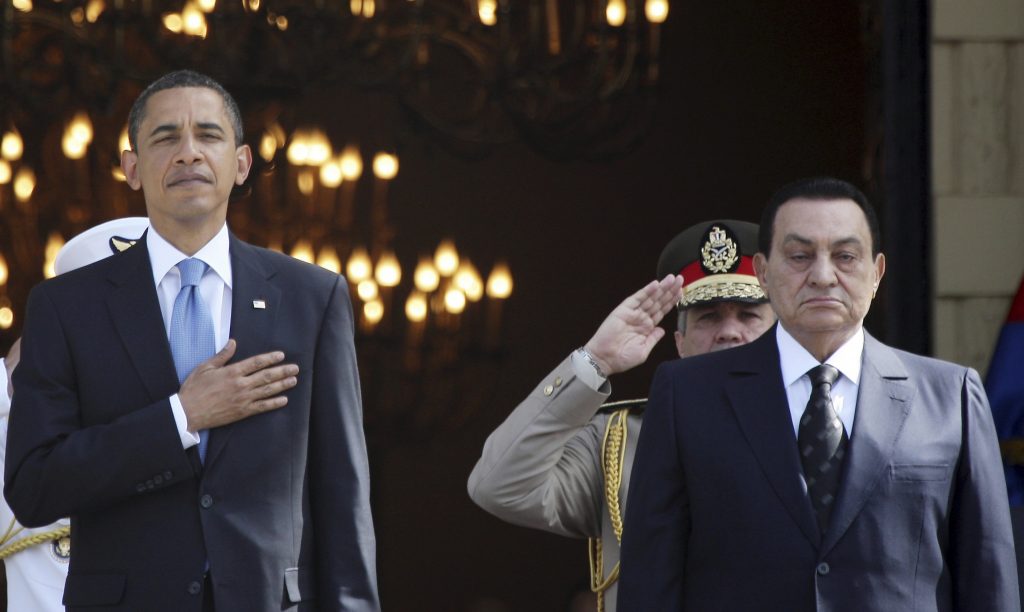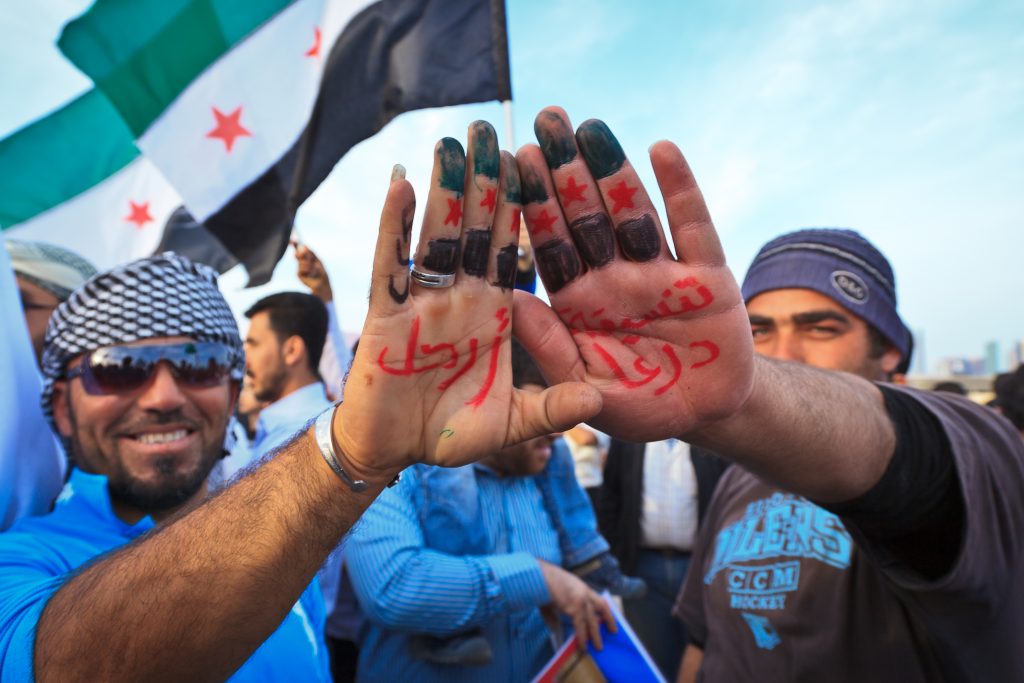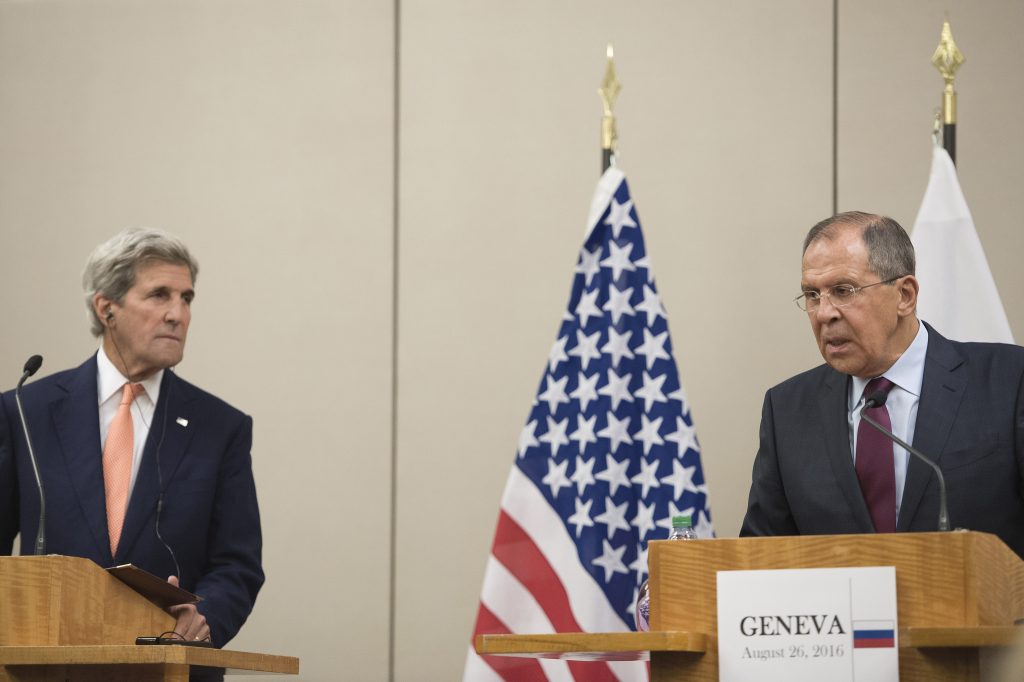Will the United States be indispensable to Syria’s future? As a bombastic President Donald Trump settles into the Oval Office, questions re-emerge about the U.S. role in Syria’s popular uprising-turned-civil and regional war. In a complicated domestic landscape, Trump appears to have at least initially bet more on the rising wave of xenophobic American populism than on the civic pluralist identity (and economic sensibility) helping make the U.S. a nation of immigrants. Reflecting the confluence of international and domestic politics, Trump’s “Muslim ban” cites the threat of terrorism as it halts immigration from seven Muslim-majority countries, including Syria.
Yet Trump’s single-minded focus on ISIS is no sudden departure from years of U.S. policy toward Syria. The new president’s professed admiration for Russian President Vladimir Putin, an unrelenting backer of Syrian President Bashar Assad, may simply make for clearer consistency between U.S. diplomatic-speak and policy in coordinating with Russia. But in viewing Syria primarily through a counterterrorism prism, Trump picks up where his predecessor left off. New, perhaps, is the more inflammatory discourse and an apparent willingness to dispense with the “soft power” considerations of U.S. foreign policy.
The “Obama doctrine,” which hails the nuclear deal with Iran as its crowning achievement, will be debated for years. But by many accounts, former President Barack Obama’s Syria policy was a string of failures: a failure to back up the call for Assad to “step aside,” a failure to deliver on the chemical weapons “red line,” a failure to stem the creeping tide of ISIS rampages, a failure to secure humanitarian aid to areas under siege, a failure to negotiate a “political solution” to an armed conflict now engulfing the Middle East and involving four permanent members of the United Nations Security Council, and above all, a failure to prevent the slaughter of half a million Syrians and the forced displacement of half the country’s population. Even outgoing Secretary of State John Kerry defensively touting the administration’s “assertive diplomacy” has admitted leaving behind many problems in the “chronically combustible” Middle East.
Yet with respect to Syria, President Obama was smashingly successful at one thing: shifting the policy approach away from an embrace — or at least toleration of — a regionwide quest for freedom and dignity (hurriyah and karamah), to one of counterterrorism. The “new beginning” with the Muslim world Obama promised in Cairo in 2009, earnestly stressing that popular aspirations for political participation, just government, the rule of law and individual freedoms were “human rights, which is why we will support them everywhere,” could have found a foothold in the 2011 Arab Spring.

Barack Obama with Hosni Mubarak on his 2009 trip to Cairo. Flickr/Muhammad Ghafari.
But Obama launched a renewed war on terror, concretely inaugurated in fall 2014 through Operation Inherent Resolve against al-Qaida spinoff ISIS after it suddenly captured territory in Iraq and Syria. The resulting waiting game has lent longevity to the Assad regime, whose military was rescued by Russia on counterterrorism pretexts. It has facilitated Moscow’s ventures to bypass the terms of a political settlement established in the U.S. and Russian-sponsored Geneva Communique of 2012. Thus Russia can attempt to impose a draft constitution on the opposition in talks held in the Kazakh capital Astana in early 2017, try to reconfigure the makeup of the internationally recognized Syrian opposition, and even delay the next round of political negotiations.
Obama’s farewell address, an ode to a domestically minded American exceptionalism rather than its missionary variant, made no mention of Syria or any Arab Spring country. The outgoing president simply pledged, “ISIL will be destroyed.” Trump’s inaugural “America first” speech more glaringly neglected the Middle East, declaring war on “Islamic terrorism, which we will eradicate from the face of the earth.”
Silmiyyah, Silmiyyah
That a blundering U.S. policy on Syria is anchored in a war-on-terror fixation is a supreme irony of the bloodied and bloodying trajectory of the uprising. In their 2011 protests and activism, Syrians sought to engage the U.S.-led “international community” to convince Obama of the moral legitimacy and pressing humanist, even democratic, nature of their demands. Symbolized by icons like Ghiyath Matar, Abdelbaset Saroot, Ibrahim Qashoush, and the abducted Razan Zeitouneh, they stressed the civil, peaceful (silmiyyah) and inclusive modes of their dissent against Assad and a determination to rid the country of martial law.
The Syrian thawrah (revolution) began as a bottom-up attempt at a nonviolent overhaul of political and security institutions to rebalance relations between state and society and open up space for more congenial, complementary and participatory interactions between them. Thus a dark paradox hangs over the militarized and internationalized transformation and fragmentation of its popular mobilization, which is now directed not just at Assad’s regime, but also Russia, Hezbollah, Iran and other foreign militias. Syria’s amalgamation is further complicated by the petrodollars, arms transfers and attendant influence of “friendly” states, from the Gulf to Turkey, in addition to transnational militant groups ISIS and Jabhat al-Nusrah-turned-Fath al-Sham.
But Obama’s determination to be “on the right side of history,” through a declared commitment to siding with the Arab people’s pursuit of political freedom, seems forgotten, from Abdel Fattah el-Sisi’s Egypt to Assad’s Syria.
The capacity to define the “terrorist,” a contested label in the best of scenarios, has instead become a central axis of U.S. and international dealings with Syria. This “business as usual” may be unsurprising in light of the U.S. war on terror orienting its Middle East policies for the past 15 years, even in presumably softer domains such as democracy and civil society support. Long dismissed as ludicrous by the opposition and even American officials, U.S. discourse bears uncanny resemblances to Assad’s plotline. The opthalmologist-dictator’s warnings of terrorist mayhem as he repressed the country’s peaceful protests in 2011 now appear a self-fulfilling prophecy.

Syrians in Doha calling for Assad’s departure in the early days of the Arab Spring. Flickr/Omar Chatriwala.
But as during the aftermath of the 9/11 attacks, the U.S.-determined terrorism label (gleefully adopted by Arab autocrats) is rife with inconsistencies and normative transgressions. As Judith Butler has noted, it demarcates which bodies are “grievable” and which tactics and targets of violence and counter-violence are legitimate or reprehensible. Obama’s upgraded war on terror taps into an expansive discursive, institutional, intelligence and alliance repertoire rooted in the decade of counterterrorism preceding Mohammad Bouazizi’s torch-lighting in Tunisia that sparked the Arab Spring. But with Syria, whose sanctioned “rogue” regime had borne American economic and diplomatic ire years before Assad’s violent crackdowns in 2011, a marked change is notable. Not-so-secret American and Syrian “security” collaboration through practices such as extraordinary rendition has given way to greater priority and policy congruity placing counterterrorism front and center.
Increasingly, Russia takes the helm of the counterterrorism ship, its coordination with the U.S. superseding disagreements such as those over Ukraine. In August 2016, the U.S. acquiesced to targeting al-Nusra jointly with Russia. Even the opposition has adapted its discourse to the counterterrorism frame. In his opening statement at the ceasefire talks in Astana in January 2017, opposition delegation leader Mohammad Alloush recalled armed oppositionists’ yearslong fight against state and ISIS terrorism, demanding that militias fighting alongside the regime be designated as terrorists and combated accordingly.
“The Right Side of History”?
It was not always this way. In May 2011, months into the Arab Spring, Obama proclaimed U.S. policy to be in support of reform and democratic transition. He lauded “the moral force of nonviolence” outperforming decades of terrorism in the region. “Smart” American power firmly inserted the U.S. on the side of “the people,” differentiating between errant dictators and the publics with whom the U.S. “share[d] a bond of common humanity.”
Punitive measures crystallized against Assad in August 2011 as the U.S. announced new sanctions rebuking him for civilian slaughter. Obama unforgettably called on Assad to “lead the transition, or get out of the way.” The U.S. formed the Friends of Syria group and pledged logistical support to “moderate” members of the opposition. The thuwwar’s (revolutionaries’) disjointed armed wing of Free Syrian Army and other so-called Islamist battalions rose in prominence vis-à-vis the lethargic Syrian National Council-turned-Coalition in exile. The U.S. and Russia outlined a blueprint for a Syrian-led “political transition” in the Geneva Communique of June 2012. By December 2012, invocations of a security threat crept into American discourse, with the terrorist designation of al-Qaida affiliate Al-Nusra Front.
Obama issued a now ill-famed warning of “surgical airstrikes” against Assad if he ventured to use chemical weapons. Assad took the dare, so to speak, orchestrating a chemical weapons massacre of more than 1,000 people in Eastern Ghouta in August 2013. Searing images of foaming mouths and trembling infant bodies were added to his crime log. The U.S. president’s retreat from his administration’s wide interpretation of the War Powers Act, as he tossed the decision-making power to a Congress expected to vote down airstrikes against Israel’s neighbor, was an about-face. Secretary of State Kerry entreated Congress that American moral commitments, strategic interests and credibility were all on the crimson-hued line. The administration’s vacillation was publicly censured in the State Department “Dissent Memo” of summer 2016.
Ultimately, Kerry and Russian counterpart Sergei Lavrov devised an inventive fix: Assad would destroy or hand over Syria’s chemical weapons stockpile. This UN agreement shocked oppositionists who had correctly or incorrectly expected U.S. airstrikes to deliver a defeating blow to Assad. For many, optimism gave way to frustration as the red line became a “green light” for further Assad brutality.

John Kerry and Sergei Lavrov at the Geneva Convention in 2016. Flickr/UN Geneva.
Thus the chemical weapons deal — followed shortly by an announcement of the impending Joint Comprehensive Plan of Action with Iran — was a turning point. Kerry highlighted the regional and global security benefits of eliminating Assad’s chemical weapons stockpile. He insisted the agreement would be a springboard for the slippery “political solution” sought by the U.S. and Russia. This diplomatic closure of the chemical weapons massacre was distanced in U.S. discourse from Syria’s uprising and war. Assad would later disregard the agreement, using chemical weapons on multiple occasions.
Given its hyper-militarized foreign policy, the U.S decision to use force in Syria a year later in Operation Inherent Resolve was less notable than the direction in which it was wielded. The target of American military wrath was not Assad’s regime but a delinquent offspring of the familiar enemy, al-Qaida. In this battle of the rogues, nonstate terrorism outdid state repression.
Pursuant to this U.S. war on terror trajectory has been closer alignment with (if not deference to) Russian positions blatantly supporting Assad. Direct Russian military action in Syria since late 2015 putatively targets terrorists but bombs opposition fighters and civilians, homes and hospitals. Carving away at the opposition’s territorial gains, this bombardment enabled Assad’s resurgence on the ground. With his Grozny “scorched earth” credentials, Putin has been in his element. The first world leader to call President George W. Bush on 9/11 is a sympathetic security-as-counterterrorism campaigner, even when American officials decry Russian airstrikes in Syria.
Politically, the subsequent U.S.-Russian — and Iranian — adjudicated Vienna Communique and UNSC Resolution 2254 steadily etched away at the Geneva foundation, even as both documents (negotiated sans-Syrian) purported to uphold its articles. Assad might now run in future elections; all state institutions, including the dreaded security-intelligence apparatus, are to be kept whole in the political transition — of a “secular” state, in a new provision. A treaty between Russia and Syria signed in January 2017, renting the Hmeimeim airbase to Moscow for 49 years (and up to 25 more), gives Russian military presence additional permanence and contractual cover.
Bolstered by the deadly series of Russian airstrikes, Iranian and other militias on the ground, and a crippling lack of coordination among opposition ranks, Assad recaptured besieged eastern Aleppo in December 2016. The forced evacuations and demographic restructuring of Syria’s landscape, in a pattern unfolding again in Wadi Barada in January 2017, add long-term devastation to immediate starvation and slaughter. Among opposition activists and writers, references abound to the “Palestinianization” of Syria’s revolution.
An uncertain future
It remains to be seen what Trump may do in Syria or elsewhere. He has given no indication yet that he plans to reclaim U.S. leadership of the “Syria file” from Russia, but things may change. No U.S. delegation attended the Astana talks in January, ostensibly held to strengthen the ceasefire negotiated by Russia, Turkey and Iran. The U.S. ambassador in Kazakhstan instead “observed” the proceedings.
The Iran deal, the exact fate of the “operating rooms” through which the U.S. has been coordinating its fluctuating military assistance to “vetted” Free Syrian Army groups in conjunction with regional allies, are all open questions. As President-elect, Trump hinted at cutting off this support, references to a possible “safe zone” — long sought by Syrian oppositionists and Turkey — were dropped from the executive order on immigration, reappearing in a phone call between Trump and the Saudi king. Yet such plans bear at best a tenuous quality, the safe zone’s enforceability guarantors and mechanisms unclear. Assad’s departure will not necessarily be a condition for a Trump-approved settlement in a fractured state, its territorial control divided among the regime, ISIS, the fragmented opposition and Kurdish groups.
For now, Russian ascendancy in the Middle Eastern geo-political landscape leaves few waiting to take their cues from the U.S.
Trump’s immigration ban, its legal and popular legitimacy already challenged, is certainly unwelcome to Syrians and others it keeps out of the U.S. Here, Trump appears to depart from previous presidents. Even in his global war on terror, President Bush underscored the emulative capacity and persuasive power of the affirmative “American values” of democracy, individual freedoms and even pluralism. Presumed to deliver counterterrorism dividends, this soft power is a pillar of U.S. foreign policy as access to oil, Israeli security and nuclear nonproliferation remain key interests in the Middle East. President Obama continued this “smart power” strategy. Alongside its selective use of military force in the anti-ISIS campaign, which also arms the much-criticized Kurdish YPG, the U.S. has dispensed billions of dollars in humanitarian assistance to Syria. Out of the millions displaced, it has also admitted thousands into the country through its refugee program.
America’s smart power is easily liable to critiques of inefficacy, inconsistency and hypocrisy. But humanitarianism has been as persistent a feature of American diplomatic discourse as emphases on human rights, democracy and economic entrepreneurship. Despite an executive order mentioning the use of “public diplomacy” to help counter ISIS, for the moment Trump sounds out of tune with his presidential predecessors. The question for Syrians is what to make of this unabashed bluntness and off-script maneuvering.
For now, Russian ascendancy in the Middle Eastern geo-political landscape leaves few waiting to take their cues from the U.S. The elusive unity of anti-regime fighters — who face off against Assad, Hezbollah, Iranian and other foreign militias (including from Iraq and Afghanistan), Russia, ISIS and more recently Jabhat Fatah-al-Sham — remains a requirement to tip the balance in their favor. Widely decried catastrophic opposition infighting, compounded with the increasing unreliability of regional backing, makes for very bleak military and political prospects. “Geneva 4” appears no more promising than the past two rounds of peace talks.
As Trump initially upsets the diplomatic and domestic political scene, Syrians cannot expect the U.S. to facilitate the survival that is a prelude to citizenship, let alone their full-throated calls for freedom and dignity that even many armed oppositionists appear to have forgotten. But what else is new?
*Image: Palmyra, Syria in 2007. Flickr/ David Holt.





